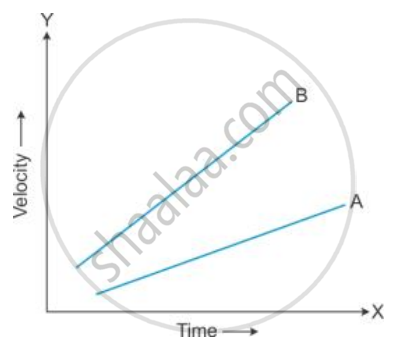Advertisements
Advertisements
प्रश्न
A body is moving vertically upwards. Its velocity changes at a constant rate from 50 m s-1 to 20 m s-1 in 3 s. What is its acceleration?
उत्तर
Here, final velocity = 20 m/s
Initial velocity = 50 m/s
Time taken = 3 s
Acceleration = `("Final Velocity - Initial Velocity")/"time"`
= `(20 - 50)/3` m/s-2
= -10 m/s-2
Negative sign here indicates that the velocity decreases with time, so retardation is -10 m/s-2.
APPEARS IN
संबंधित प्रश्न
Define the term acceleration due to gravity. State its average value.
Figure shows the velocity-time graphs for two cars A and B moving in the same direction. Which car has greater acceleration? Give reasons to your answer.

The acceleration of a body is 8.5 ms-2. What does this statement mean?
State if the following situation is possible:
A body moving with a constant velocity in an accelerated motion.
The graph shows how the velocity of a scooter varies with time in 50 s.
Work out: Acceleration.
A car accelerates to a velocity of 30 m/s in 10 s and then decelerates for 20 s so that it stops. Draw a velocity-time graph to represent the motion and find:
The acceleration.
The rate of change of velocity is ______.
A car is being driven at a speed of 20ms-1 when brakes are applied to bring it to rest in 5 s. The deceleration produced in this case will be ______.
The value of acceleration for a body at rest is ______.
What is the difference between uniform acceleration and non–uniform acceleration?
